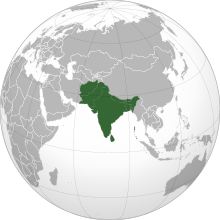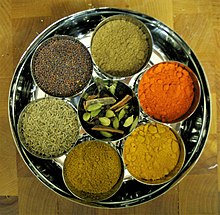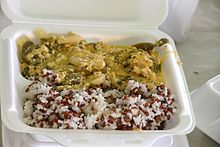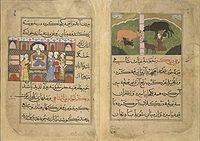South Asian cuisine

South Asian cuisine, includes the traditional cuisines from the modern-day South Asian republics of Bangladesh, India, Maldives, Nepal, Pakistan and Sri Lanka, also sometimes including the kingdom of Bhutan and the emirate of Afghanistan. Also sometimes known as Desi cuisine, it has been influenced by and also has influenced other Asian cuisines beyond the Indian subcontinent.
Staples and common ingredients

Foods in this area of the world are flavoured with various types of chilli, black pepper, cloves, and other strong herbs and spices along with the flavoured butter ghee. Ginger is an ingredient that can be used in both savory and sweet recipes in cuisines from the subcontinent. Chopped ginger is fried with meat and pickled ginger is often an accompaniment to boiled rice. Ginger juice and ginger boiled in syrup are used to make desserts. Turmeric and cumin are often used to make curries.
Common meats include lamb, goat, fish, chicken and
History
Many foods from the subcontinent have been known for over five thousand years. The Indus Valley people, who settled in the northwestern subcontinent, hunted turtles and alligator. They also collected wild grains, herbs and plants. Many foods and ingredients from the Indus period (c. 3300–1700 B.C.) are still common today. Some consist of wheat, barley, rice, tamarind, eggplant, and cucumber. The Indus Valley people cooked with oils, ginger, salt, green peppers, and turmeric root, which would be dried and ground into an orange powder.
Indians have used leafy vegetables, lentils, and milk products such as yogurt and ghee throughout their history. They also used spices such as cumin and coriander. Black pepper, which is native to India, was often used by 400 A.D. The Greeks brought saffron and the Chinese introduced tea. The Portuguese and British made red chili, potato and cauliflower popular after 1700 A.D. Mughals, who began arriving in India after 1200, saw food as an art and many of their dishes are cooked with as many as 25 spices. They also used rose water, cashews, raisins, and almonds.
In the late 18th and early 19th century, an autobiography of the Scottish
-
ancient India.[3]
-
A page from theNimatnama-i-Nasiruddin-Shahi, the book of delicacies and recipes. It documents the fine art of making kheer.
-
Medieval Indian Manuscript Nimatnama-i-Nasiruddin-Shahi (circa 16th century) showing samosas being served.
By culture
Afghan cuisine
Bangladeshi cuisine
Bangladeshi cuisine is dominated by Bengali cuisine and has been shaped by the diverse history and riverine geography of Bangladesh. The country has a tropical monsoon climate. Rice is the main staple food of Bangladeshi people and it is served with a wide range of curries.
Bhutanese cuisine

Bhutanese cuisine employs a lot of red rice (like brown rice in texture, but with a nutty taste, the only variety of rice that grows at high altitudes), buckwheat, and increasingly maize. The diet in the hills also includes chicken, yak meat, dried beef, pork, pork fat, and mutton. It has many similarities with Tibetan cuisine.
Indian cuisine
Indian cuisine is characterized by its sophisticated and subtle use of many
Regional cuisine includes:
- East Indian cuisines:
-
Bengali Fish meal
-
Odisha style Mutton Curry
-
Eastern India
- Northeast Indian cuisines:
-
Assamese Thali
-
Tan Ngang a bread from Manipur
-
Traditional North Indian Vegetarian Thali, India
-
South Indian vegetarian Thali, India
-
Fish moolie Kerala Style
- West Indiancuisines:
- Goan cuisine
- Gujarati cuisine
- Maharashtrian cuisine
- Malvani cuisine
- Parsi cuisine
- Sindhi cuisine
- Thathai Bhatia Cuisine
-
Pav Bhaji a popular fast food from Mumbai, Maharashtra
- Other Indian cuisines include:
-
A popular Indian Chinese dish
-
Samosa with Pudina Chutney
Maldivian cuisine
Maldivian cuisine, also called Dhivehi cuisine, is the cuisine of the Nation of Maldives and of Minicoy, India. The traditional cuisine of Maldivians is based on three main items and their derivatives: coconuts, fish and starches.
-
Masroshi Maldivian savory snacks
Nepalese cuisine
Nepalese cuisine comprises a variety of cuisines based upon ethnicity, soil and climate relating to Nepal's cultural diversity and geography.Dal-bhat-tarkari (Nepali: दाल भात तरकारी) is eaten throughout Nepal.Nepali cuisine has significant influences from Neighboring Indian and Tibetan cuisines.
Nepalese cuisine includes:
- Newa cuisine
- Tibetan cuisine
- Maithil cuisine
-
Dal-bhat-tarkari is a traditional dish in Nepalese cuisine
-
Plateful of Momo in Nepal
Pakistani cuisine
Pakistani cuisine (
Regional cuisines include:
- Balochi cuisine
- Chitrali cuisine
- Kalash cuisine
- Lahori cuisine
- Cuisine of Karachi
- Pashtun cuisine
- Punjabi cuisine
- Saraiki cuisine
- Sindhi cuisine
-
Chapli kebab, a popular kebab from Pashtunistan
-
Sajji, a popular meat dish of Balochistan
-
Ghalmandi with cottage cheese and herbs from Chitral
Other Pakistani cuisine include:
- Pakistani Chinese cuisine
- Mughlai cuisine (Karachi)
- Pakistani fast food
Sri Lankan cuisine
Sri Lankan cuisine has been shaped by many historical, cultural, and other factors. Foreign traders who brought new food items; influences from Malay cuisine and South Indian cuisine are evident.
-
Sri Lankan rice and curry platter
See also
References
- Daily Star. Vol. 7, no. 49. Retrieved 1 May 2019.
- Robert Lindsay. "Anecdotes of an Indian life: Chapter VII". Lives of the Lindsays, or, A memoir of the House of Crawford and Balcarres. Vol. 4. p. 99 – via National Library of Scotland.
- ^ Staelens, Stefanie. "The Bhang Lassi Is How Hindus Drink Themselves High for Shiva". Vice.com. Retrieved August 10, 2017.
- ^ "Bangladesh – Language, Culture, Customs and Etiquette". Archived from the original on 2014-07-29. Retrieved 2018-04-05.
- ^ "A Tale Of Bhojpuri Cuisine". Slurrp. Retrieved 2022-10-26.

![Bhang eaters from India c. 1790. Bhang is an edible preparation of cannabis native to the subcontinent. It has been used in food and drink as early as 1000 BCE by Hindus in ancient India.[3]](http://upload.wikimedia.org/wikipedia/commons/thumb/b/b4/Bhang_eaters_before_two_huts_%286124556163%29.jpg/200px-Bhang_eaters_before_two_huts_%286124556163%29.jpg)


































